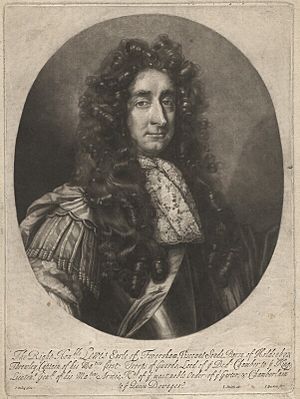Louis de Duras, 2nd Earl of Feversham facts for kids
Quick facts for kids
The Earl of Feversham
|
|
|---|---|
 |
|
| Born | c. 1641 |
| Died | 19 April 1709 (aged 67–68) London, England
|
| Spouse(s) | Mary Sondes (m. 1676) |
| Children | 7 |
| Military career | |
| Allegiance | |
| Service/ |
|
| Rank | Colonel |
| Unit | Life Guards |
| Battles/wars | |
| Awards | Order of the Garter |
Louis de Duras, 2nd Earl of Feversham (born around 1641, died 19 April 1709) was an important English Army officer and a noble. He was born in Kingdom of France and came from a famous French family called Durfort. His mother was related to a well-known French military leader, Henri de La Tour d'Auvergne. Louis de Duras was a Huguenot, which means he was a French Protestant.
Contents
Early Life and Moving to England
Louis de Duras was born in France around 1641. His family was very important, and his two brothers even became Marshals of France, a very high military rank.
In 1663, when he was about 22, Louis de Duras moved to England. He came with James, Duke of York, who later became King James II. Soon after arriving, he became a naturalized citizen of England. This meant he had the same rights as someone born in England.
Becoming a Noble in England
Louis de Duras quickly gained favor in England. In 1673, he was given the title Baron Duras. This made him a member of the English peerage, which is a group of nobles. His title came from an estate he bought in Northamptonshire.
In 1676, he married Mary Sondes. Her father, Sir George Sondes, was made the Earl of Feversham that same year.
Inheriting the Earldom
When his father-in-law, Sir George Sondes, passed away in 1677, Louis de Duras inherited his titles. This is how he became the 2nd Earl of Feversham. Sadly, his wife Mary died just two years later in 1679.
Military and Royal Service
Louis de Duras, now the Earl of Feversham, served the English kings Charles II and James II in many important roles. He was a Colonel in the Life Guards, a special army unit.
Serving King Charles II
King Charles II gave him command of different troops of Horse Guards. Feversham also went on several important trips abroad as a diplomat, representing England. He became the Master of the Horse in 1679, which was a high position in the royal household. He was also the Lord Chamberlain to Queen Catherine of Braganza, King Charles II's wife, starting in 1680.
In 1682, he became a Lord of the Bedchamber. This meant he was a close attendant to the king. He was even present when King Charles II was dying.
Role in Monmouth's Rebellion
When James, Duke of York, became King James II, Feversham became a member of the Privy Council. This was a group of advisors to the king.
In 1685, a rebellion started against King James II. It was led by Monmouth. The Earl of Feversham was given the main command of the king's army to fight the rebels. His forces defeated Monmouth's army at the Battle of Sedgemoor. After the battle, Feversham was known for how he treated the defeated rebels.
For his success, King James II rewarded him. Feversham received the Order of the Garter, a very high honor, and was made the colonel of the first troop of the Life Guards. In 1686, he was put in charge of a large army gathered by King James on Blackheath.
Later Life and Legacy
After King James II was removed from power in the Glorious Revolution, the Earl of Feversham managed to make peace with the new king, King William III. This was thanks to Queen Catherine, the widow of Charles II, who spoke up for him.
Because of Queen Catherine's help, Feversham was given the leadership of the Royal Hospital of St Katherine in London in 1698. He died on 19 April 1709, without any children. He was first buried in the Savoy in London, but his remains were later moved to Westminster Abbey in 1740.

